Top 10 Most Handsome Anime Characters Of All Time
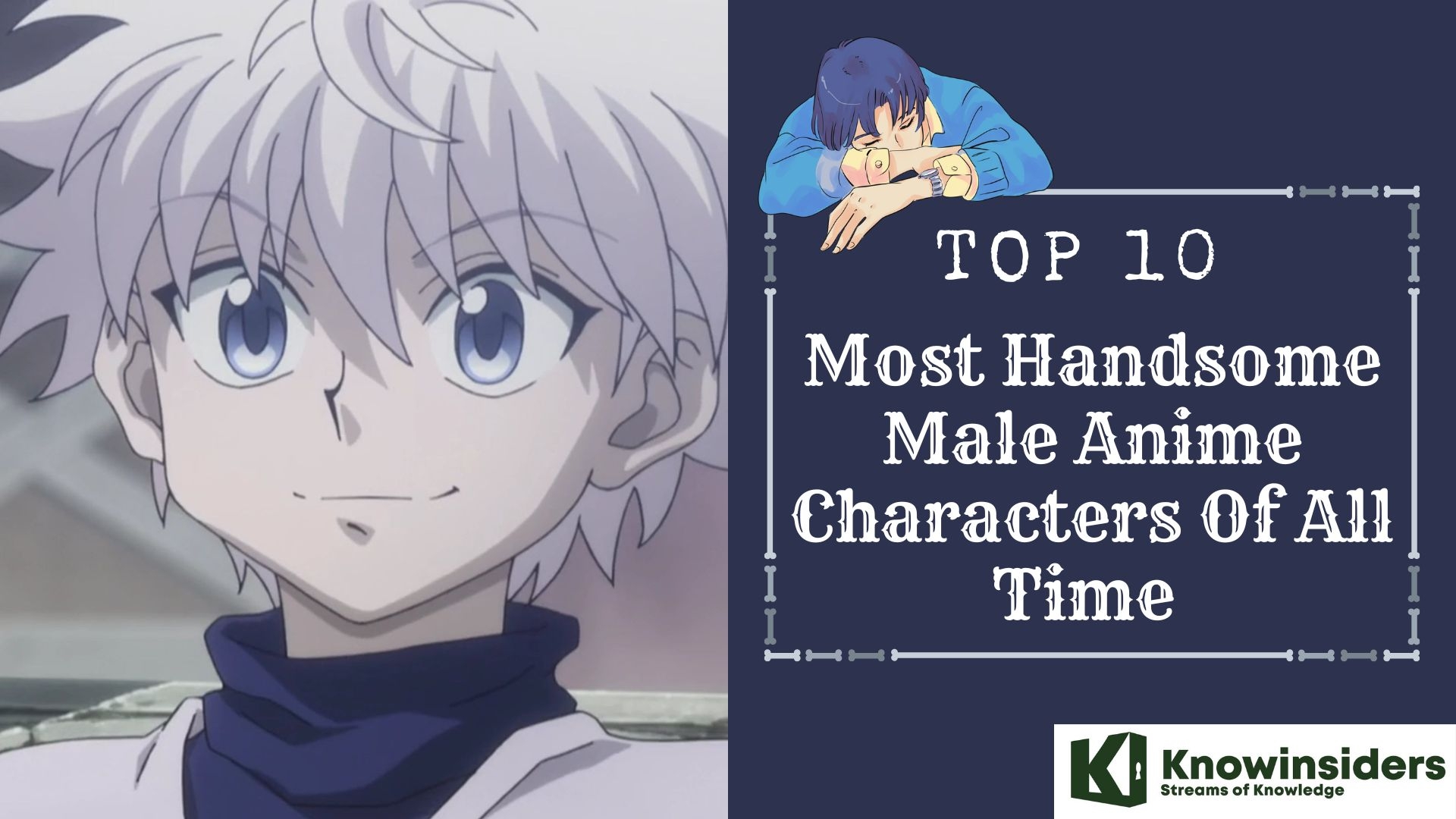 |
| Top 10 Most Handsome Male Anime Characters Of All Time Knowinsiders.com |
| Table of Content |
Anime offers a complete package filled with emotions, drama, entertainment, amazing plot twist, stunning visuals – and of course, admirable characters.
No matter how good or bad the show is, an anime is always defined by its characters. A good-looking, charming, and badass hero is the backbone of an anime. Believe it or not but many popular cult-favorite anime characters have millions of fans.
Here is the 10 most handsome male anime characters of all time for you anime fans.
What Does "Anime" Mean?
Anime can easily be the most addictive form of comic art. Having showered its readers with spellbinding characters and storylines, the art form continues to churn out new ones from its cavern of infinite imagination. Often offering bizarre and captivating characters, anime often reforms a comic book reader’s perception of stories and characters, introducing them to new horizons of retinal excitement. With big studios sweeping the rights for major anime’s and giving them the much deserved big-screen rendition, one can only hope they serve justice to the art form.
Anime is a term for a style of Japanese comic book and video cartoon animation in which the main characters have large doe-like eyes.
Anime is the prevalent style in Japanese comic books or manga. In Japan, the comic book is a popular form of entertainment for adults as well as for younger audiences. Story lines are often very sophisticated and complex and extend into episodic series. Typical anime themes or genres include Ninja and other martial arts; the supernatural or horror story; the romance; and science fiction including robots and space ships. Foils for the main characters, including robots, monsters, or just plain bad people, often lack the doe-eyed quality.
Also adding to the emotional feel of anime are the technical animation tricks like dramatic closeups and zooms, intense lighting, and brilliant colors. But beyond its distinctive visual look, anime has endeared itself into the hearts of fans because of its complex characters and engaging plotlines.
Top 10 Most Handsome Male Anime Characters In History
1. Levi Ackerman — Attack on Titan
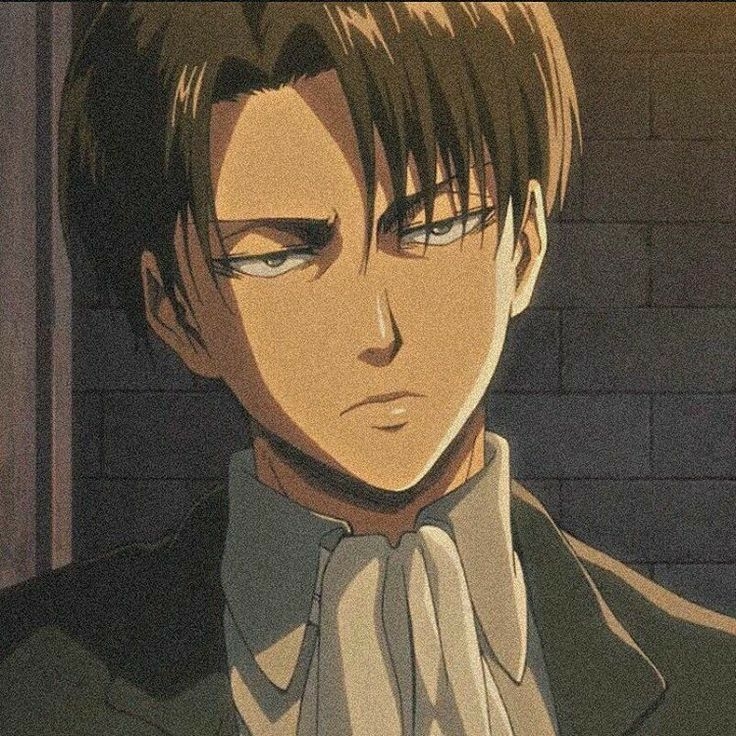 |
| Photo: Pinterest |
"I want to put an end to that recurring nightmare, right now. There are those who would get in my way. But I'm fine playing the role of the lunatic who kills people like that. I have to be ready to rearrange some faces. Because I choose the hell of humans killing each other over the hell of being eaten."
— Levi explains his mentality to his squad
Levi Ackerman (リヴァイ・アッカーマン Rivai Akkāman?), often formally referred to as Captain Levi (リヴァイ兵長 Rivai Heichō?), is the squad captain (兵士長 Heishichō?, lit. "leader of the soldiers") of the Special Operations Squad within the Survey Corps and is widely known as humanity's strongest soldier.
Levi has short, straight black hair styled in an undercut curtain, as well as narrow, intimidating dull gray eyes with dark circles under them and a deceptively youthful face. He is quite short, but his physique is well-developed in musculature from extensive vertical maneuvering equipment usage. He is usually either frowning or expressionless; that, plus his extremely calm demeanor, often makes it difficult for others to guess what he is thinking.
He is most often seen in his Survey Corps uniform, with a light gray button-up shirt underneath, along with his trademark white ascot. When embarking on expeditions outside the Walls, he also wears the Survey Corps' green hooded cloak. Once, when forced to take leave from his duties due to injury, Levi was seen in a black suit, plain white shirt, ascot, and dress shoes. However, since the beginning of the coup d'état, he has left the ascot off. For most of the time during which the Survey Corps was on the run from the military and monarchy, he simply wore his vertical maneuvering equipment harness over casual clothes.
After a close-encounter explosion from a Thunder Spear set off by Zeke Yeager, Levi now has several scars across his face including one across his right eye and is missing both the index and middle fingers on his right hand.
2. Kakashi Hatake — Naruto
 |
| Photo: Pinterest |
Kakashi Hatake (Japanese: はたけ カカシ, Hepburn: Hatake Kakashi) is a fictional character in the Naruto manga and anime series created by Masashi Kishimoto. In the story, Kakashi is the teacher of Team 7, consisting of the series' primary characters, Naruto Uzumaki, Sasuke Uchiha, and Sakura Haruno. He is initially portrayed as a detached and apathetic figure, but as the series progresses, his loyalty to his friends and students becomes increasingly apparent. Kakashi's past has been extensively explored in the series, resulting in a gaiden being devoted to his past experiences. Kakashi has appeared in several pieces of Naruto media, the featured films in the series, the original video animations, and the video games.
Kakashi was originally created by Kishimoto to be a harsh teacher but the author decided to avoid that. Instead, he made him more generous to calm his students in difficult situations to the point of giving him feminine traits. Kakashi's design gave Kishimoto difficulties as a result of having most of his face covered and as a result it was difficult to show his emotions. For the anime series, he is voiced by Kazuhiko Inoue in Japanese and Dave Wittenberg in the English dub.
Numerous anime and manga publications have praised and criticized Kakashi's character. Although he has been noted to be an echo of similar detached shōnen manga characters, the duality of Kakashi's apathetic and serious sides have been praised. Kakashi has been highly popular with the Naruto reader base, placing high in several popularity polls. Merchandise based on Kakashi has also been released, including key chains and plush dolls.
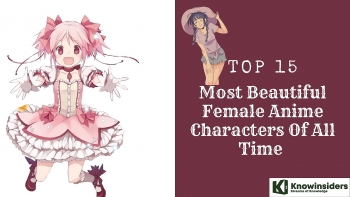 Top 15 Most Beautiful Anime Characters Of All Time Top 15 Most Beautiful Anime Characters Of All Time Anime has been very popular lately, and many female anime characters are perfectly written and made that they got our love and heart. |
3. Itachi Uchiha
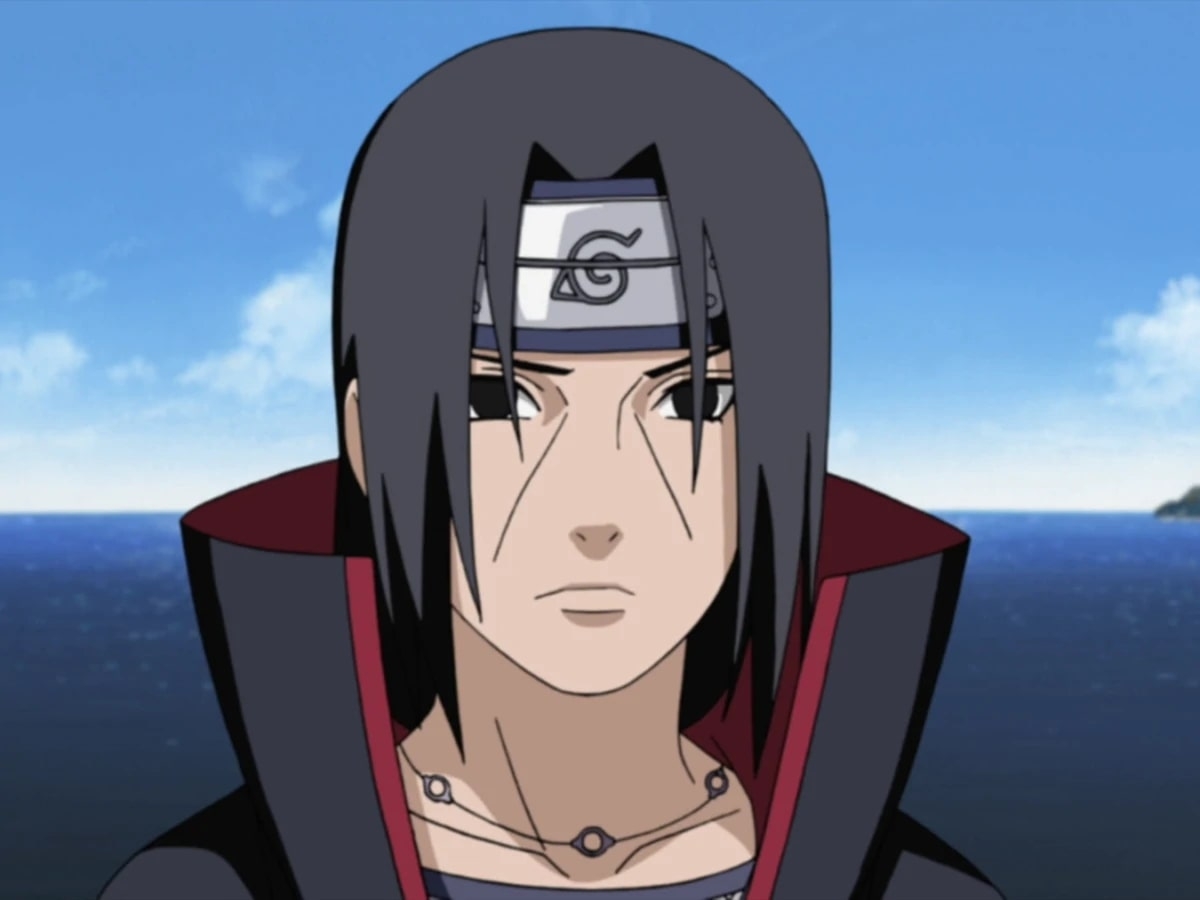 |
| Photo: Narutopedia |
Itachi Uchiha (うちはイタチ, Uchiha Itachi) was a shinobi of Konohagakure's Uchiha clan who served as an Anbu Captain. He later became an international criminal after murdering his entire clan, sparing only his younger brother, Sasuke. He afterwards joined the international criminal organisation known as Akatsuki, whose activity brought him into frequent conflict with Konoha and its ninja — including Sasuke who sought to avenge their clan by killing Itachi. Following his death, Itachi's motives were revealed to be more complicated than they seemed and that his actions were only ever in the interest of his brother and village, making him remain a loyal shinobi of Konohagakure to the very end.
Itachi Uchiha is one of the most famous anime characters of all time. He is the most popular edge lord in the anime world. He is popular due to his older brother whose t-shirts and mixtapes he stole. Itachi Uchiha is not a protagonist but an anti-hero. He kills the entire Uchiha clan except for his brother Sasuke. Despite his negative characteristics, fans love him. His mysterious history, dreamy eyes, cool moves, and sexy personality make him an attractive male anime character. Itachi has millions of fans around the world with dedicated fandom websites.
Even within the famed and battle-adept Uchiha clan, Itachi was a genius of such talent, he consistently showed prowess well-beyond his years, effortlessly learning new jutsu from simple observation, and rising rapidly through the ninja ranks. His prowess rivalled Shisui Uchiha, who was well-regarded as the strongest Uchiha of their time. He was highly proficient in all three main ninja skill sets and gained praise from allies and foes alike; Orochimaru, one of the Sannin, openly admitted Itachi was stronger than he was. Obito revealed that despite being weakened from illness and Sasuke having absorbed Orochimaru's power, Itachi could have killed Sasuke during their battle if he wanted to. Even when restraining himself, a team of jōnin were still pushed to their limits against Itachi.
4. Megumi Fushiguro
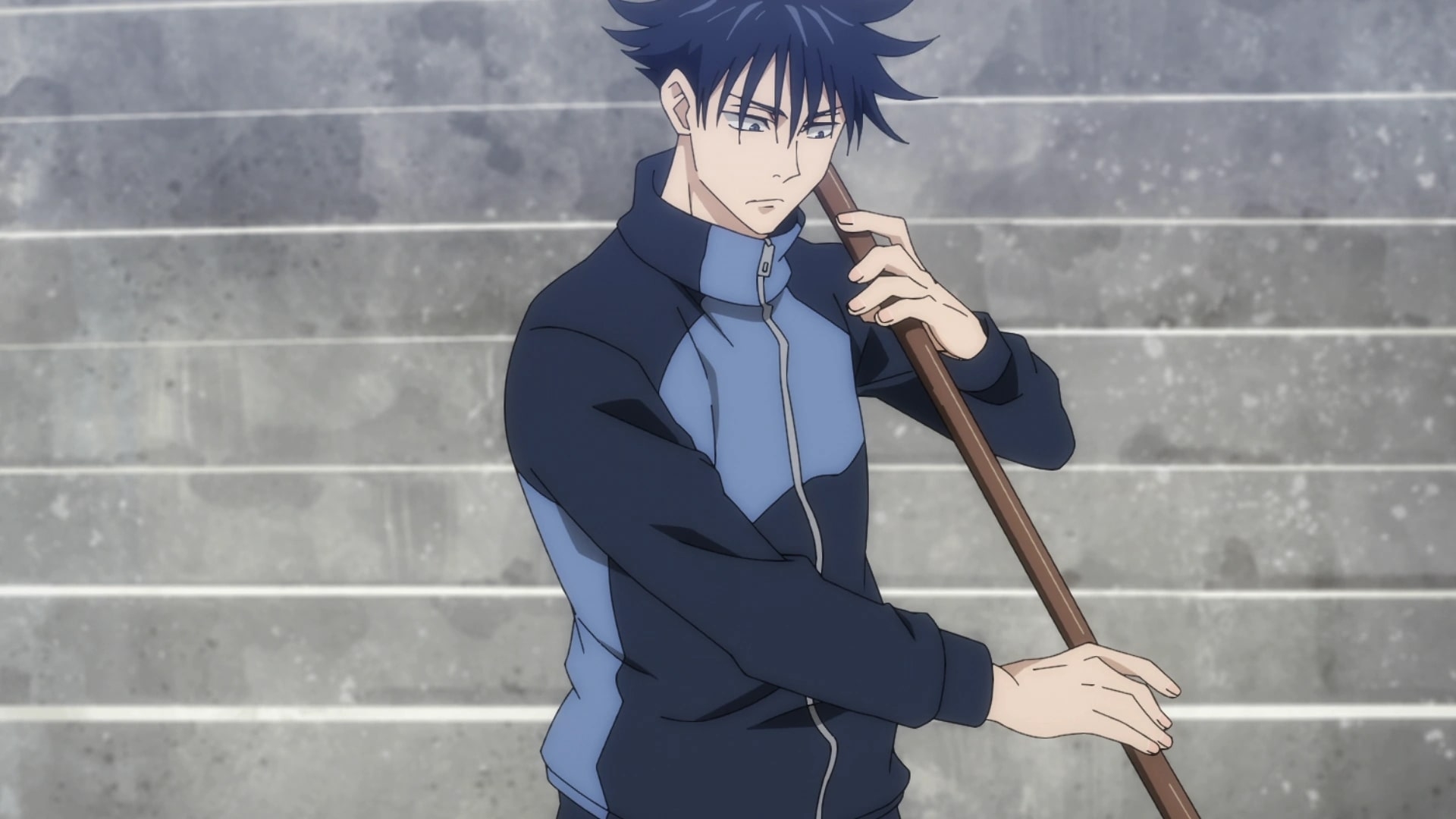 |
| Photo: Jujutsu Kaisen |
Megumi Fushiguro (伏ふし黒ぐろ恵めぐみ Fushiguro Megumi?) is the deuteragonist of the Jujutsu Kaisen series. He is a grade 2 jujutsu sorcerer and first-year student at Tokyo Jujutsu High alongside Yuji Itadori and Nobara Kugisaki. Megumi is the step-brother of Tsumiki Fushiguro and as the son of Toji Fushiguro, Megumi is also a descendant of the Zenin Family. Megumi was born outside the clan as Toji's trump card and was eventually found by Satoru Gojo, who mentored him and enrolled him at Jujutsu High as his student.
Megumi is a relatively tall, slim young man with fair skin and green eyes (dark blue in the anime adaptation). He has uniquely styled black hair with long spikes that jut out in every direction around his head, resembling a sea-urchin (according to Hakari).
Megumi typically wears a standard Jujutsu High uniform with a dark blue jacket over a long-sleeved white dress shirt. His uniform pants match his jacket and only reach to just above his shins. He wears long black socks that cover his exposed ankles and finishes his outfit with low-top brown shoes. He also has a blue tracksuit for training.
In middle school, Megumi wore the Saitama Urami East Junior High uniform, which consisted of a tan jacket over a white dress shirt with black pants and sneakers. While sneaking inside the Gachinko Fight Club, Megumi wore a black hoodie and matching pants with his normal shoes as a disguise.
5. Yuji Itadori
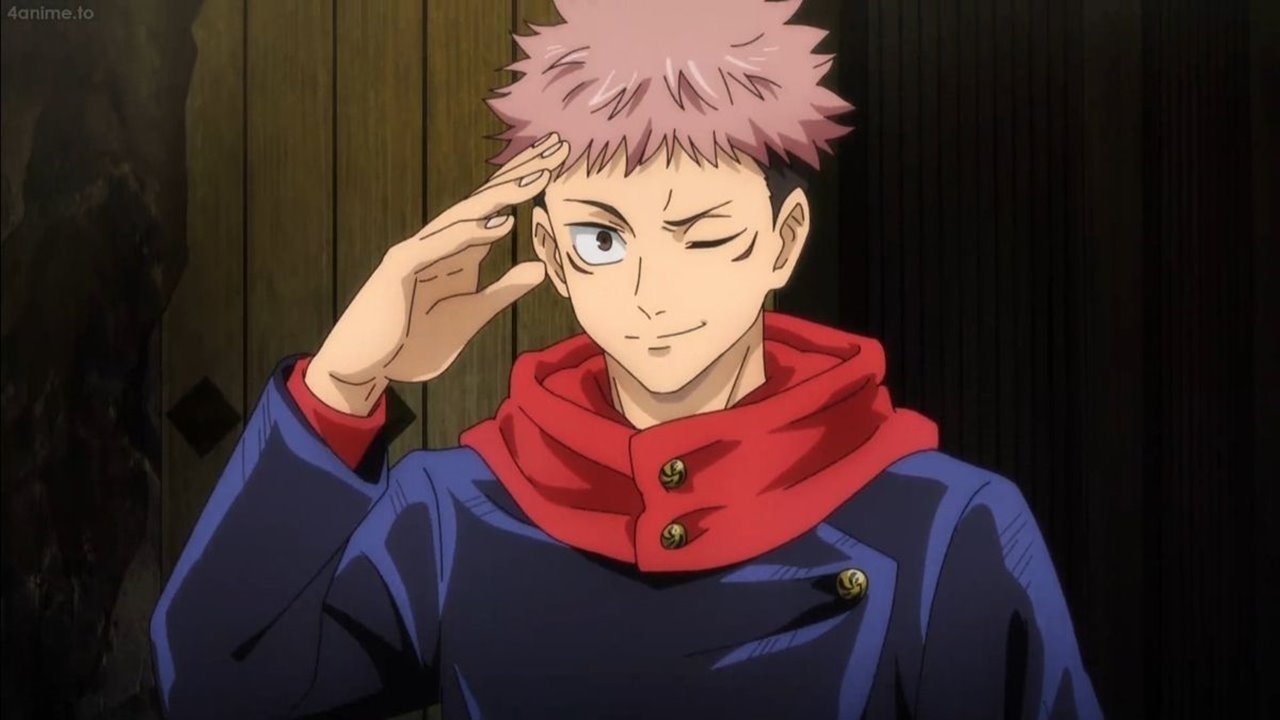 |
| Photo: Jujutsu Kaisen Fandom |
Yuji Itadori (Japanese: 虎杖悠仁, Hepburn: Itadori Yūji) is a fictional character and the main protagonist of the manga series Jujutsu Kaisen created by Gege Akutami. Yuji is a first-year jujutsu sorcerer at Tokyo Jujutsu High who is thrown into the world of sorcery after eating one of twenty fingers belonging to Ryomen Sukuna (宿儺, Sukuna), a powerful cursed spirit—a being manifested from cursed energy from the negative emotions flowing from humans. With his classmates, Yuji exorcises curses while trying to honor his grandfather's legacy and save others unconditionally so that when he is executed after eating all twenty fingers, he will not be alone in his death.
Throughout the series, Yuji and exceptional cursed techniques are developed as he faces down different curses and the emotional blowback of his actions. Despite having only practiced using cursed energy for a few months, Yuji is tremendously powerful even without having become Sukuna's Vessel. Yuji believes strongly in the value of life and works to make sure everyone he meets, no matter how deep his connection to them may be, receives proper treatment.
In the anime adaptation of the manga, Yuji is voiced by Junya Enoki in Japanese and Adam McArthur in English. The character has been received positively by critics, with many praising his character development though some critics were divided if he is a proper unique shōnen protagonist.
6. Giyu Tomioka
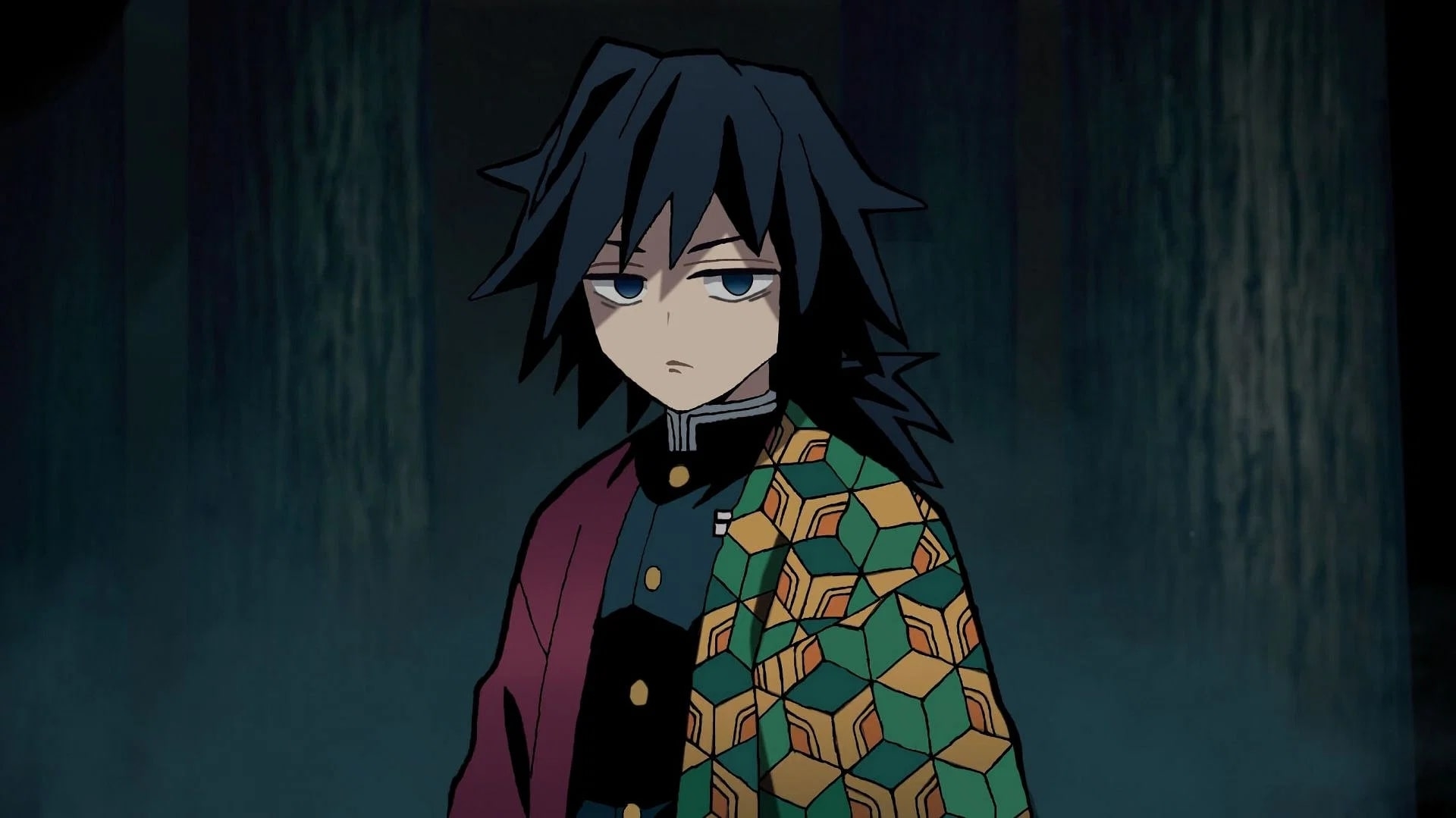 |
| Photo: Pinterest |
Giyu Tomioka (富とみ岡おか 義ぎ勇ゆう Tomioka Giyū?) is a major supporting character of Demon Slayer: Kimetsu no Yaiba. He is a Demon Slayer of the Demon Slayer Corps and the current Water Hashira (水みず柱ばしら Mizu Bashira?).
Giyu is a tall young man of a muscular stature and pale complexion, who is almost always seen wearing a serious and emotionless expression. He has unruly black hair of uneven lengths that sticks up in tufts around his head, which he wears tied back in a low messy ponytail at the base of his neck. His bangs fall over his eyes in an uneven fringe. His eyes are sharp and moderately large, their irises a deep sapphire that fades to a lighter blue and their pupils a bluish-black, and are framed by thin eyebrows.
Giyu wears a dark cyan-tinted version of the standard Demon Slayer uniform with buttoned white leg-wrapped kyahan and a pair of white zōri with dark blue straps and tabi socks underneath being the same cyan color as his uniform. Over this, Giyu wears a haori that's split down the middle into two different patterns: the right one a solid red, and the left one geometrically patterned with squares of green, orange, and yellow. These haori were later noted to have belonged to his late older sister, Tsutako Tomioka, and his deceased friend Sabito.
During his battle with Muzan Kibutsuji, he loses his right arm. After the fight, Giyu cuts his hair down to shoulder length, now wearing it loose rather than tied into a ponytail.
While Giyu was training under Sakonji Urokodaki, he wore a red haori which would later make up his current one as well as black tucked-in tattsuke-hakama pants and his current white leg-wrapped kyahan and pair of white zōri with dark blue straps. In addition, he also wears the warding masks that are signature to Sakonji's pupils. For Giyu, it is a white fox mask with light blue eyes.
7. Karma Akabane – Assassination Classroom
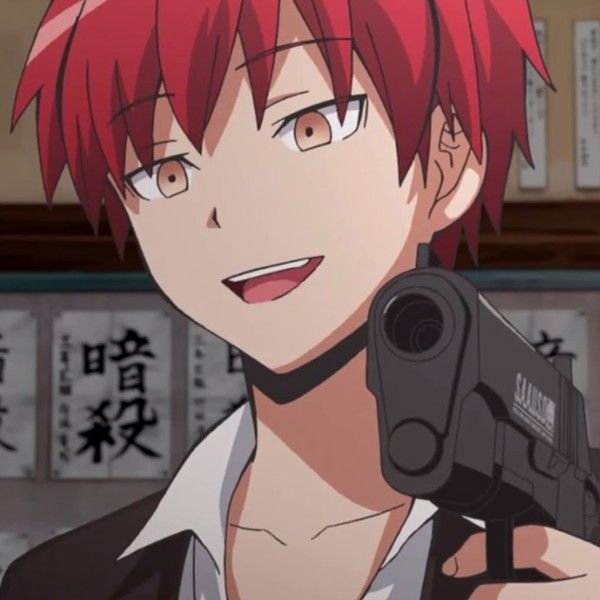 |
| Photo: Pinterest |
Karma Akabane (赤羽 業カルマ Akabane Karuma) is a student in Korosensei's Class 3-E of Kunugigaoka Junior High School who had been suspended from school due to his violent behavior and one of Nagisa's closest friends.
Karma has pale skin, short red hair, and pale sharp eyes that appear as either mercury or goldish in color. Behind his usual innocent-looking, smiling face hides a torturous and rather sadistic personality. He has a slender build and has also been shown to have exceptionally sharp canine teeth.
Among all the Class 3-E students, Karma is the only one to wear a black blazer as opposed to the standard school-issued uniform. In the anime, Karma is considered to be the most physically attractive out of all the boys in Class E by the girls.
Seven years after graduation, Karma has grown considerably taller and has swept-back hair. His eyes also appear moderately less threatening.
10 Most Famous Anime Characters of All Time
8. Katsuki Bakugou – My Hero Academia
 |
| Photo: Fandom |
Katsuki Bakugo (Japanese: 爆豪 勝己, Hepburn: Bakugō Katsuki), also known by his nickname Kacchan (かっちゃん, Katchan) and his hero name Great Explosion Murder God Dynamight (大・爆・殺・神ダイナマイト, Daibaku Kisshin Dainamaito), is a superhero and one of the main protagonists of the manga series My Hero Academia, created by Kōhei Horikoshi. As a child, Katsuki often bullied the quirkless Izuku Midoriya. However, after they both entered UA High School and Katsuki lost to Izuku in training, he began to see him differently. After Katsuki is kidnapped by the league of villains, All Might loses his quirk in the process of saving him, which made him blame himself for All Might's retirement, though All Might later reassures him it was not his fault. Katsuki later becomes one of the only people who know the true nature of Izuku's quirk One for All. Katsuki's quirk is Explosion (爆破), which allows him to make explosions from his hands by detonating the nitroglycerin-like substance he sweats; throughout the series, he learns various different ways to apply this. Overuse of the quirk can potentially break his forearms.
Katsuki has received positive reviews from critics, with many praising his character development throughout the series and his relationship with Izuku.
In the first draft of the series, Katsuki was a genius with a nice personality, though Horikoshi scrapped this idea because it was too boring. Instead, he decided to make the character nasty and unlikable. Horikoshi originally intended to keep Katsuki with the nasty and unlikable personality, though later decided to give him development so people wouldn't hate him. After the series' anime adaptation premiered, Horikoshi began writing the character with Nobuhiko Okamoto's voice in mind. Horikoshi had not expected Katsuki to become a popular character, so he was surprised to see the character rank well in the popularity polls.
Katsuki's English voice actor, Clifford Chapin, has commented that he often has to end recording sessions early due to his voice getting worn out from all the screaming the character does. Chapin prefers voice acting the more calmer and emotional scenes with the character, even making the character accidentally sound too vulnerable at times.
9. Tetsuro Kuroo
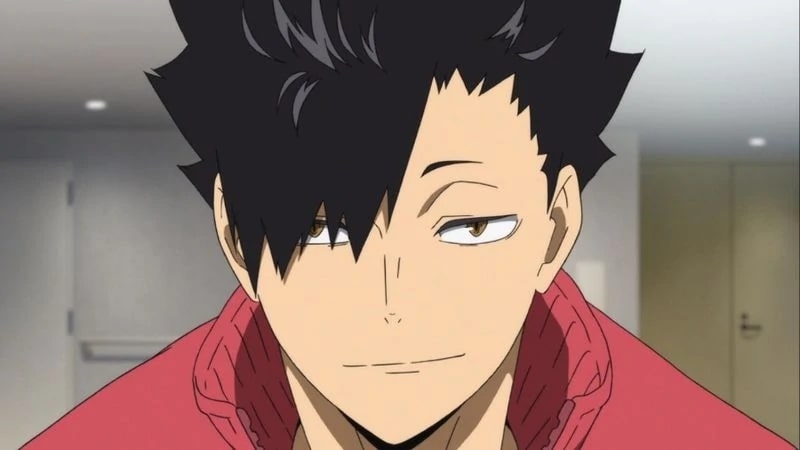 |
| Photo: Haikyuu!! Fandom |
Tetsurō Kuroo (Japanese: 黒尾くろお 鉄朗てつろう Kuroo Tetsurō) is a third year student from Nekoma High. He is captain of the boys volleyball team and plays as a starting middle blocker.
As of November 2018, he is part of the Japan Volleyball Association's sports promotion division.
Kuroo is noted to be tall and lean with broad shoulders, well-built arms, and a muscular frame. He has narrow, hazel colored (grey in the manga) eyes with cat-like pupils that make him appear sly and intimidating. His black hair is naturally messy and spikes upwards due to his bed head. He also has a fringe on his right side that partially covers his eye. As a result of his peculiar hairstyle, he is occasionally called "Rooster Head".
Kuroo is often seen wearing a black shirt, red sweatpants, and the Nekoma High jacket. During official matches, he wears the Nekoma uniform numbered with the number 1.
10. Killua Zaoldyeck – Hunter X Hunter
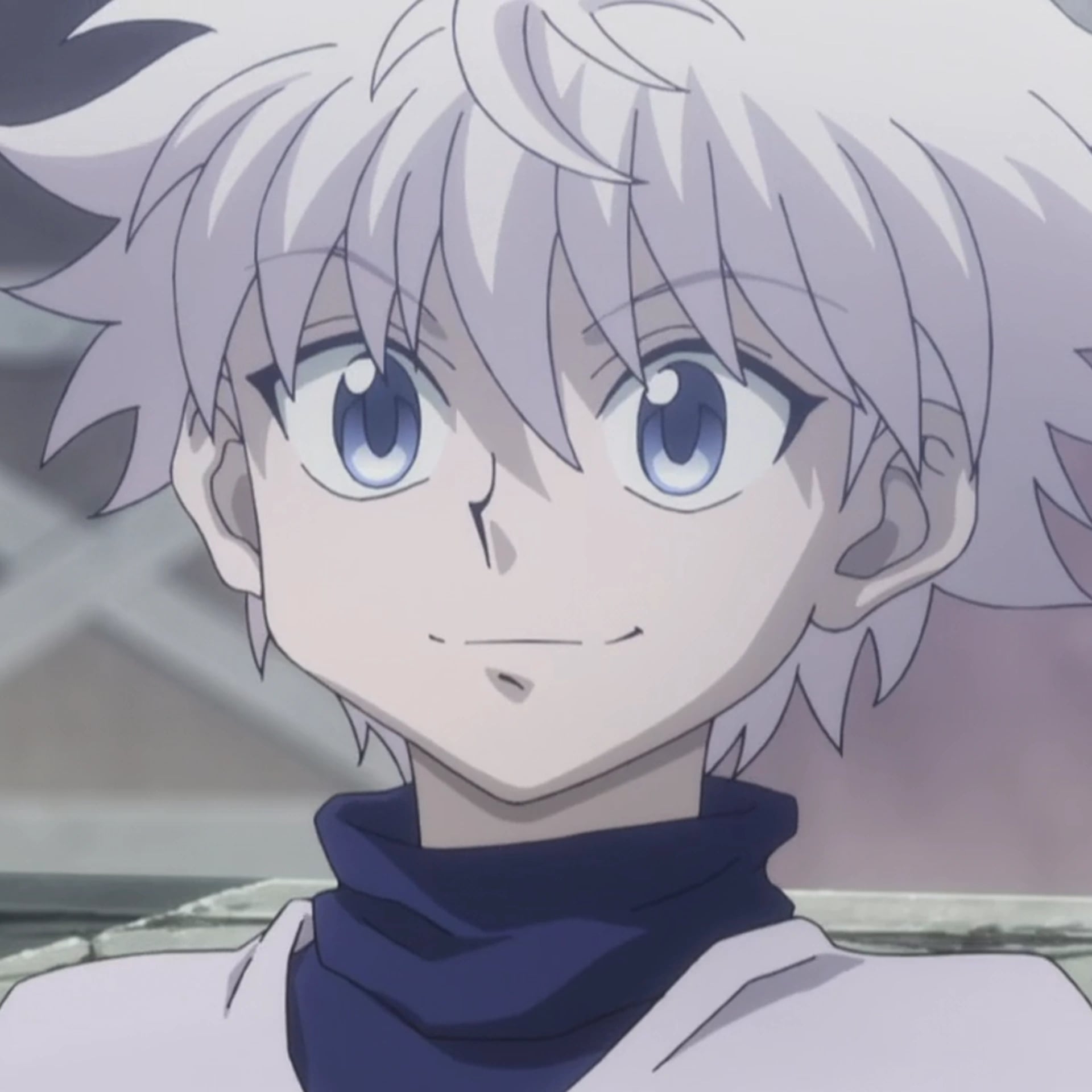 |
| Photo: Hunterpedia |
Killua Zoldyck (キルア゠ゾルディック, Kirua Zorudikku) is the third child of Silva and Kikyo Zoldyck and the heir of the Zoldyck Family, until he runs away from home and becomes a Rookie Hunter. He is the best friend of Gon Freecss and is currently traveling with Alluka Zoldyck.
He has served as the deuteragonist for the series, having said role in the Heavens Arena, Greed Island, and Chimera Ant arcs. He was the main protagonist of the 13th Hunter Chairman Election arc. He also was the tritagonist of the Hunter Exam arc and the Yorknew City arc.
Killua has spiky silver hair, very pale skin, and blue eyes. His eyes change shape depending on the mood that he's in, narrowing and sharpening when he goes into assassination mode. Killua is fairly lean at the start of the series, due to constant physical conditioning and torture training he received when he was young. As time passes, he becomes more muscular and toned. In the Nippon Animation anime adaptation, Killua's eye color is changed to green during the OVAs. He is also often seen holding a green skateboard (turned yellow in the 2011 series).
Killua typically wears baggy clothing, with his usual attire consisting of long-sleeved and dark-colored shirts. Most of his clothes have a turtleneck. Killua wears long, baggy shorts in the manga and Madhouse animated adaptation, but Nippon Animation's character design shortened them to reach above his knees. Killua also wears purple boots, recolored brown and black in the Nippon Animation adaptation.
As a child, Killua's hair is longer, almost cascading to his shoulders. He wore a hoodie with his trademark blue coloring, grey pants, and shoes.
What makes "Anime" so popular?
In 2016 the Japanese anime industry took home a record $17.7 billion with revenue, up just under 10% and the result of seven years consecutive growth for the industry, according The Association of Japanese Animation (AJA). Domestic box office with anime features was up by 14% and total overseas revenue sales boosted by nearly a third compared to the previous year. So why is anime so popular?
Anime and manga have long been at the heart of Japanese culture, with a consistent wave of popularity between the generations. Over recent years, the popularity for anime and its comic strip counterpart manga has grown considerably in the UK and the West.
One of the main reasons why anime has stood the test of time and grown in popularity across the world is due to its unique ability to grow with its viewers. The famous anime expert, Takamasa Sakurai, claims that the genre has been widely accepted due to its unconventional nature, “Japanese anime broke the convention that anime is something that kids watch”. Overseas fans of anime claim that they enjoy the intensity of the storylines with the endings being difficult to predict as anime is often targeted at adult audiences.
In the UK, many children watched anime TV shows as they were growing up, namely: Dragon Ball Z, Pokémon and Yu-Gi-Oh! At the time of watching, kids won’t have realised that they were watching Japanese animation but the popularity of the shows meant that it created a soft spot in their hearts for anime. Now, with the growth of the internet and streaming services such as Netflix, it has meant that anime has become much more accessible and accommodating for adults to relive their childhoods through more age-appropriate popular anime films. These include Spirited Away and TV programmes such as A Place Further than the Universe.
Anime has become more popular overseas in recent years due to a shrinking Japanese population leading to an increased export-minded trade. This has meant that anime producers have started to make content more suited to Western tastes, as well as producing anime overseas as it is much cheaper. Famous anime producers such as Tezuka now produce and push for their work to be sold internationally.
History of Anime
Anime dates back to the birth of Japan’s film industry in the early 1900s and has emerged as one of Japan’s major cultural forces over the past century.
Much of the work done in these early years was not the cel animation technique that would come to be the dominant production technique, but a host of other methods: chalkboard drawings, painting directly on the film, paper cut-outs, and so on.
One by one, many of the technologies used today were added to Japanese animated productions—sound (and eventually color); the multiplane camera system; and cel animation. But due to the rise of Japanese nationalism and the start of WWII, most of the animated productions created from the 1930s on were not popular entertainments, but instead were either commercially-oriented or government propaganda of one type or another.
Post-War and the Rise of TV
It wasn’t until after WWII—in 1948, to be precise—that the first modern Japanese animation production company, one devoted to entertainment, came into being: Toei. Their first theatrical features were explicitly in the vein of Walt Disney’s films (as popular in Japan as they were everywhere else). One key example was the ninja-and-sorcery mini-epic Shōnen Sarutobi Sasuke (1959), the first anime to be released theatrically in the United States (by MGM, in 1961). But it didn’t make anywhere near the splash of, say, Akira Kurosawa’s Rashōmon, which brought Japan’s movie industry to the attention of the rest of the world.
What really pushed animation to the fore in Japan was the shift to TV in the Sixties. The first of Toei’s major animated shows for TV during this time were adaptations of popular manga: Mitsuteru Yokoyama’s Sally the Witch and the “kid with his giant robot” story Tetsujin 28-go was adapted for TV by Toei and TCJ/Eiken, respectively. Ditto Shotaro Ishinomori’s hugely-influential Cyborg 009, which was adapted into another major Toei animated franchise.
First Exports
Up until this point, Japanese animated productions had been made by and for Japan. But gradually they began to show up in English-speaking territories, although without much in the way to link them back to Japan.
1963 heralded Japan’s first major animated export to the U.S.: Tetsuwan Atomu—more commonly known as Astro Boy. Adapted from Osamu Tezuka’s manga about a robot boy with superpowers, it aired on NBC thanks to the efforts of Fred Ladd (who later also brought over Tezuka’s Kimba the White Lion). It became a nostalgia touchstone for several generations to come, although its creator—a cultural legend in his own country—would remain largely anonymous elsewhere.
In 1968, animation studio Tatsunoko followed the same pattern—they adapted a domestic manga title and ended up creating an overseas hit. In this case, the hit was Speed Racer (aka Mach GoGoGo). The man responsible for bringing Speed to the U.S. would be none other than Peter Fernandez, a hugely important figure in anime’s spread beyond Japan. Later, Carl Macek and Sandy Frank would do the same for other shows, setting a pattern where a few insightful impresarios helped bring key anime titles to English-speaking audiences.
At the time these shows were released, few viewers realized they had been heavily reworked for non-Japanese audiences. Aside from beginning redubbed in English, they were also sometimes edited to remove things not acceptable to network censors. It would be a long time before an audience arose that demanded the originals as a matter of principle.
Diversification
In the 1970s, the rising popularity of TV put a major dent in the Japanese film industry—both live-action and animation. Many of the animators who had worked exclusively in film gravitated back to TV to fill its expanding talent pool. The end result was a period of aggressive experimentation and stylistic expansion, and a time where many of the common tropes found in anime to this day were coined.
Among the most important genres that arose during this time: mecha, or anime dealing with giant robots or vehicles. Tetsujin 28-go had been the first: the story of a boy and his remote-controlled giant robot. Now came Gō Nagai’s outlandish battling-robots epic Mazinger Z, and the massively influential Space Battleship Yamato and Mobile Suit Gundam (which spawned a franchise that continues unabated to this day).
More shows were showing up in other countries, too. Yamato and Gatchaman also found success in the U.S. in their re-edited and re-worked counterparts Star Blazers and Battle of the Planets. Another major hit, Macross (which arrived in 1982), was transformed along with two other shows into Robotech, the first anime series to make major inroads on home video in America. Mazinger Z showed up in many Spanish-speaking countries, the Philippines, and Arabic-speaking nations. And the earlier series Heidi, Girl of the Alps had found great popularity across Europe, Latin America, and even Turkey.
The Eighties also saw the emergence of several major animation studios that became groundbreakers and trendsetters. Former Toei animator Hayao Miyazaki and his colleague Isao Takahata set up Studio Ghibli (My Neighbor Totoro, Spirited Away) in the wake of the success of their theatrical film Nausicaä of the Valley of the Wind. GAINAX, later the creators of Evangelion, formed during this time too; they started as a group of fans making animated shorts for conventions and grew from there into a professional production group.
Some of the most ambitious productions from this period weren’t always financially successful. Gainax’s own and Katsuhiro Otomo’s AKIRA (adapted from his own manga) did poorly in theaters. But another major innovation that came along during the Eighties made it possible for those films—and just about all of anime—to find new audience long after their release: home video.
Evangelion, “Late-Night Anime” and the Internet
In 1995, GAINAX director Hideaki Anno created Neon Genesis Evangelion, a landmark show which not only galvanized existing anime fans but broke through to mainstream audiences as well. Its adult themes, provocative cultural criticism and confounding ending (eventually revisited in a pair of theatrical films) inspired many other shows to take risks, to use existing anime tropes, such as giant robots or space-opera plotlines, in challenging ways. Such shows earned a place for themselves on both home video and late-night TV, where programs aimed at mature audiences could find a time slot.
Two other major forces arose towards the end of the Nineties that helped anime find broader audiences. The first was the Internet—which, even in its early dial-up days, meant that one didn’t have to go digging through back issues of newsletters or hard-to-find books to glean solid information about anime titles. Mailing lists, websites, and wikis made learning about a given series or personality as easy as typing a name into a search engine. People on opposite sides of the world could share their insights without having to ever meet in person.
The second force was the newly-emergent DVD format, which brought high-quality home video into the home at affordable prices—and gave licensors an excuse to find and issue tons of new product to fill store shelves. It also provided fans with the best available way to see their favorite shows in their original, uncut forms: one could buy a single disc with both English-dubbed and -subtitled editions, and not have to choose one or the other.
DVDs in Japan were and still are expensive (they’re priced to rent, not sell), but in the U.S. they ended up as commodities. Soon a broad range of product from multiple licensors appeared on retail and rental shelves. That plus the start of widespread TV syndication of many more popular anime titles in English dubs—Sailor Moon, Dragon Ball Z, Pokémon—made anime that much more readily accessible to fans and visible to everyone else. A rise in the amount of English-dubbed product, both for broadcast TV and home video, produced that many more casual fans. Major video retailers like Suncoast created entire sections of their floor space devoted to anime.
The Trouble New Millenium
At the same time, anime was expanding far beyond Japan’s borders, one major upheaval after another through the 2000s threatened its growth and led many to speculate if it even had a future.
The first was the implosion of Japan’s “bubble economy” in the Nineties, which had injured the industry during that time but continued to affect things into the new millennium. Contracting budgets and declining industry revenues meant a turn towards things that were guaranteed to sell; edgy and experimental work took a backseat. Titles based on existing manga and light novel properties that were guaranteed hits (One Piece, Naruto, Bleach) came all the more to the fore. Shows that tapped into the lightweight moé aesthetic (Clannad, Kanon, ) became dependable if also disposable money-makers. Attention shifted from OAVs to TV productions which stood far more of a chance of recouping costs. Conditions in the animation industry itself, never good to begin with, worsened: more than 90% of the animators who enter the field now leave after less than three years of working brutal hours for meager pay.
Another problem was the rise of digitally-powered piracy. The Internet’s early dial-up days didn’t lend itself to copying gigabytes of video, but as bandwidth and storage grew exponentially cheaper, it became that much easier to bootleg a whole season’s worth of episodes onto a DVD for the cost of the blank media. While much of this revolved around fan distributions of shows not likely to be licensed for the U.S., too much of it was the copying of shows already licensed and readily available on video.
Another shock was the worldwide economic crunch at the end of the 2000s, which caused many more companies to either cut back or go under completely. ADV Films and Geneon were major casualties, with a large chunk of their titles moving to rival company FUNimation. The latter had become, by any measure, the single largest English-language anime licensor thanks to its distribution of the massively profitable Dragon Ball franchise. Brick-and-mortar retailers cut back floorspace devoted to anime, in part because of the market’s shrinkage but also because of the prevalence of online retailers like Amazon.
Surviving and Enduring
And yet despite all this, anime survives. Convention attendances continue to climb. A dozen or more anime titles (full series, not simply single discs) hit the shelves in any given month. The very digital networks that made piracy possible are now also being used aggressively by the distributors themselves to put high-quality, legit copies of their shows into the hands of fans. The overall presentation of anime for non-Japanese fans—the quality of English dubs, the bonus features created specifically for overseas audiences—is vastly better than it was ten or even five years ago. And more experimental work began to find an audience, thanks to outlets like the Noitamina programming block.
Most importantly, new shows continue to emerge, among them some of the best yet made: Death Note, Fullmetal Alchemist. The anime we get in the future may bear that much less a resemblance to what’s come before, but only because of anime lives and evolves along with the society that produced it and the world that savors it.
 Top 10 Best Long-Lasting Perfumes For Women Today Top 10 Best Long-Lasting Perfumes For Women Today Perfume is one of the essential items in every woman's pulses. If you are looking for the ones that have long-lasting sweet scents. |
 Top 10 Most Powerful and Worst Passports in the World for 2022/2023 Top 10 Most Powerful and Worst Passports in the World for 2022/2023 What are the Best Passports, Powerful Passports and Worst Passports in the World for 2022/2023, According to The latest Henley Passport Index. |
 How To Style Bottleneck Bangs Haircut and Top 10 Hottest Hairstyles How To Style Bottleneck Bangs Haircut and Top 10 Hottest Hairstyles Bottleneck bangs haircut is one of the new and famous hairstyles these days, and it soon become a hot trend that is loved by many ... |
 Top 10 Best Food That Can Help You Live Longer Top 10 Best Food That Can Help You Live Longer Eating and diets can play important roles in your healthy life and longevity. |


























